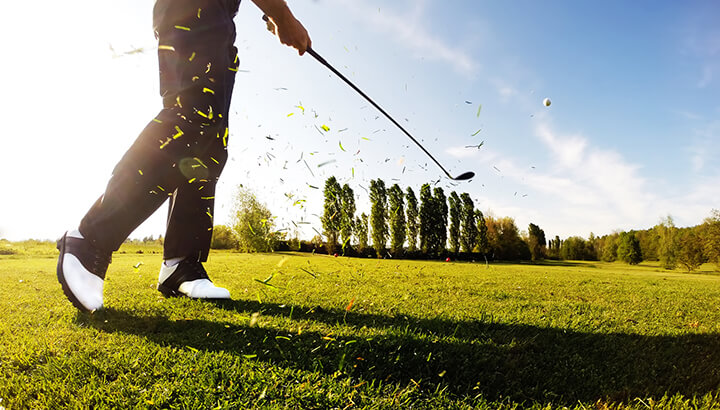Should you take a divot? Most average golfers don’t take one, and some do but before the ball (a fat shot). But you shouldn’t fear the divot, as taking one a few inches in front of the golf ball is a trait of all the greatest ball strikers. You should be making a divot with every club in your bag, with the exception of your driver and putter, and in some cases your fairway woods.
There are many reasons why you should take a divot in your golf swing, so we’ve put together a list of the main reasons why you always want a divot.
Hit down on the ball
A common fault with beginner golfers is to try and help the ball into the air. Although this makes sense as you are trying to hit the ball up, it is not true, as in order to hit consistent golf shots with your irons or wedges you need to strike down on the ball, compressing it into the turf. Hitting down on the golf ball with clean contact will eliminate all those horrible fat and thin shots.
Hanging or falling back
Taking a divot in the correct place (an inch or two in front of the ball) can be a sign that you are transferring your weight correctly through the swing. And the opposite is also true if you are not taking a divot, as you could be hanging back. This is where the center of your weight, which should be on the inside of your back foot on the backswing, stays there or even worse moves further back on your downswing, instead of moving onto your front foot. This causes the golfer to hang or fall back on the shot, making the lowest part of your swing arc far before the ball causing you to hit up on it, making you hit the dreaded thin shot and occasional fat shot.
Fix a flat swing
If you are a golfer who struggles to take turf when striking the ball, you could have a flat swing. Although most golfers can either have a flat or upright swing, and there is nothing wrong with either. Having a swing that is too flat can cause some nasty shots, like hooks, pushes and a lot of thin shots. A flat swing plane is where you swing more around your body, like a baseball swing, which shallows your angle of attack and gives a more sweeping motion than a downward blow, making it difficult to take a divot. A quick fix would be to stand slightly closer to the ball and more upright, then take the club straight back on the takeaway, this will make you feel like your swing is more up and down instead of around. This will steepen your angle of attack, helping you hit down on the ball by taking a divot.
Full extension
When you strike the ball you should be in a similar position to your address, not exactly the same, as your weight should be further in front moving to your front foot, but your lead arm should be fully extended at a similar length to that in address, with your rear arm slightly bent. This lead arm should be extending down and through the ball after impact, creating a small shallow divot just after the ball. The reverse of this is where your lead arm collapses and your rear arm straightens or stays bent. This is the all too common “chicken wing,” which can cause all types of swing faults from fat, thin, a hook or a slice. If you find it hard to take a divot, this could be a factor, but it can be fixed by focusing on swinging with the left side of your body (for right handers) and extending through the ball.
Improve your release
When striking a pure iron shot, your hands should be a little ahead of the club head and ball. this is called forward shaft lean, and is essential for hitting down and taking a sufficient divot. This is done correctly by holding off your release (lag) which all the best players do until after impact, which is what we mentioned in the last point about extending down and through the golf ball. The key to remember about taking a correct divot is having the lowest part of your swing arc slightly in front of the golf ball, this guarantees you will strike down and through the ball.
We hope this article has cleared up why you should always take a divot and helped everyone out there who is struggling to take one.
— Joseph Mills
